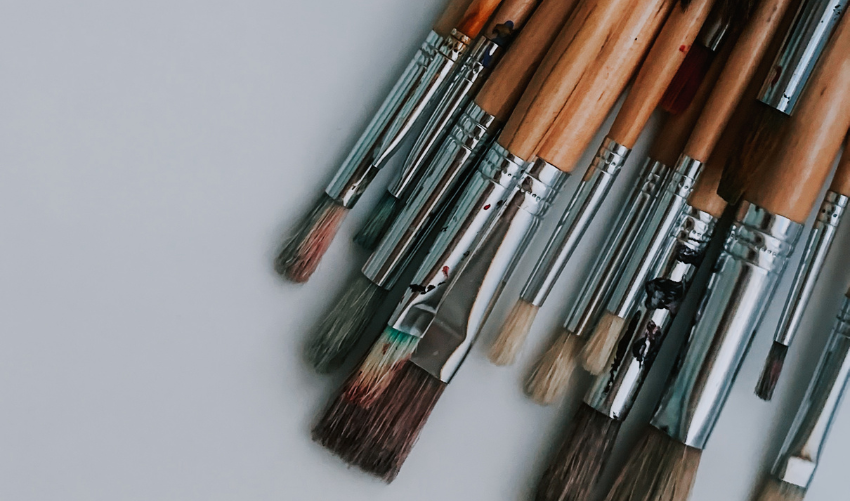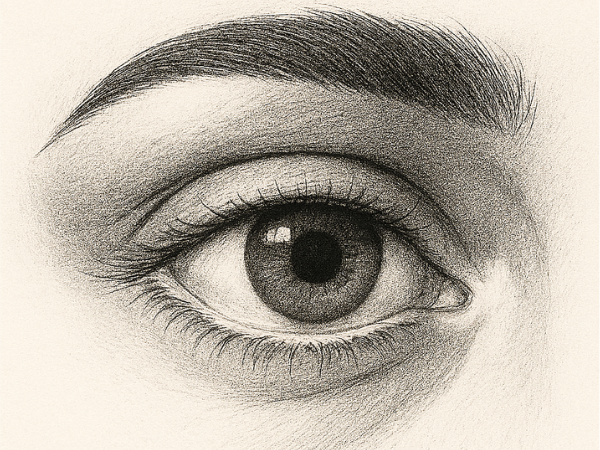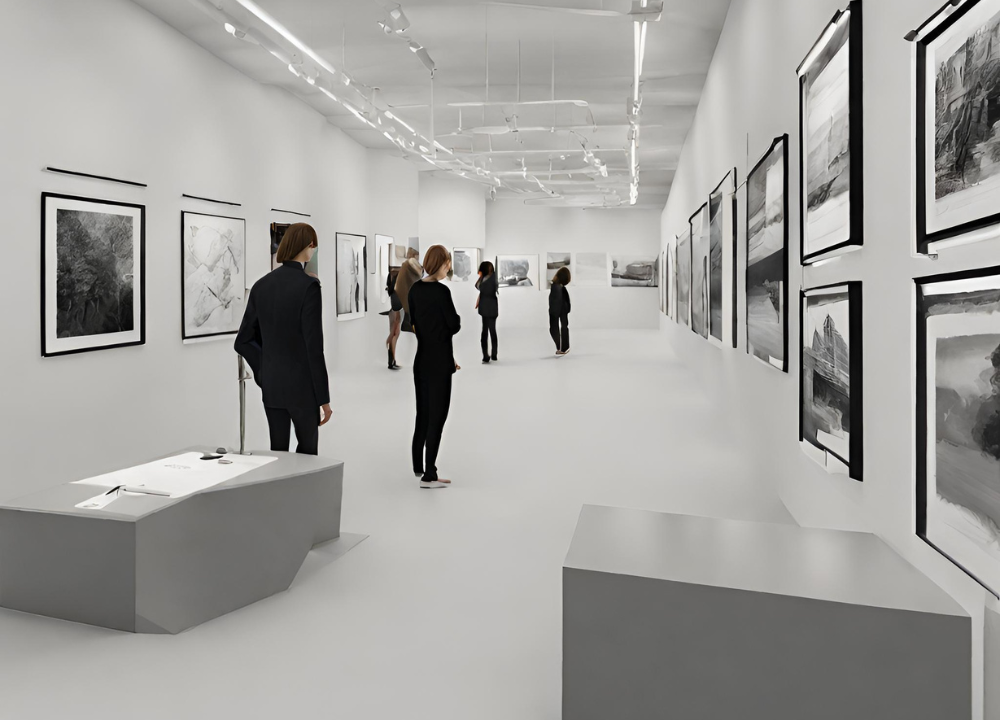Choosing the right brush can make all the difference in your painting experience. With so many shapes and bristle types available, it’s easy to feel overwhelmed.
You’ll discover the names of different brush shapes and learn how to select the perfect one for your project. Whether you’re a beginner or a seasoned artist, knowing the best uses for each brush will elevate your skills.
Brush Shapes
The right brush shape can make a big difference in your painting. Each brush shape serves a unique purpose. Understanding these shapes helps you choose the best brush for your needs. This guide explores different brush shapes, their names, bristle types, and best uses.
Round Brushes
Round brushes are versatile tools. They have a pointed tip and a circular shape. This design allows for fine details and broad strokes. Artists often use round brushes for:
- Detail work
- Lines and outlines
- Washes and glazes
Round brushes come in various sizes. Smaller sizes are great for intricate details. Larger sizes work well for covering more area. Here’s a quick look at the features:
| Size | Best Use |
|---|---|
| Small | Fine details |
| Medium | General painting |
| Large | Broad strokes |
Flat Brushes
Flat brushes have a rectangular shape. They feature a straight edge. This design is ideal for creating sharp lines and blocks of color. Common uses for flat brushes include:
- Bold strokes
- Filling in large areas
- Creating straight edges
Flat brushes can also be used for blending colors. The size of the brush affects the result. Here’s a summary of flat brush sizes and uses:
| Size | Best Use |
|---|---|
| Small | Detail work |
| Medium | Washes and blending |
| Large | Covering large areas |
Filbert Brushes
Filbert brushes combine the features of round and flat brushes. They have a rounded edge, making them perfect for soft edges and blending. Artists use filbert brushes for:
- Portrait painting
- Floral designs
- Softening edges
The rounded shape allows for versatility in strokes. Here’s how different sizes of filbert brushes can be used:
| Size | Best Use |
|---|---|
| Small | Fine details |
| Medium | General blending |
| Large | Wide strokes |
Angle Brushes
Angle brushes have a slanted edge. This unique shape helps create sharp lines and angles. Artists often use them for:
- Painting corners
- Creating precise edges
- Shading and highlighting
Angle brushes are also useful for making strokes in different directions. Here’s a quick look at their sizes and applications:
| Size | Best Use |
|---|---|
| Small | Detail work |
| Medium | Shading |
| Large | Filling larger areas |
Fan Brushes
Fan brushes have bristles arranged in a fan shape. This design is ideal for texture and special effects. Common uses include:
- Creating foliage effects
- Blending colors
- Adding texture to paintings
Fan brushes can produce unique patterns. They work well with acrylics and oils. Here’s how the sizes vary:
| Size | Best Use |
|---|---|
| Small | Fine details |
| Medium | General texture |
| Large | Creating wide textures |
Mop Brushes
Mop brushes have large, soft bristles. They are excellent for applying washes and blending colors. Artists use mop brushes for:
- Large areas of color
- Soft washes
- Blending techniques
Mop brushes hold a lot of paint, making them efficient. Here’s a quick guide to their sizes:
| Size | Best Use |
|---|---|
| Small | Detail washes |
| Medium | General washes |
| Large | Covering big areas |
Bristle Types
The right brush can make a big difference in your painting experience. Understanding the types of bristles is essential. Different bristle types affect paint application. Each type has its own benefits and best uses.

Natural Bristles
Natural bristles come from animal hair, like hog, sable, or squirrel. They are known for their softness and ability to hold paint well. Natural bristles work best with oil-based paints and varnishes.
- Soft and flexible: Great for smooth finishes.
- Excellent paint retention: Holds more paint for longer strokes.
- Ideal for blending: Perfect for creating soft edges.
Natural bristles can be more expensive. They require special care to keep them in good condition. Here’s a simple comparison table:
| Feature | Natural Bristles | Usage |
|---|---|---|
| Durability | Less durable, needs care | Oil-based paints |
| Softness | Soft and flexible | Blending and fine details |
| Price | Higher cost | Professional use |
Synthetic Bristles
Synthetic bristles are made from nylon or polyester. They are durable and versatile. These bristles work well with both water-based and oil-based paints.
- Durable: Can withstand wear and tear.
- Easy to clean: Simple to maintain and dry quickly.
- Versatile: Good for various paint types.
Synthetic brushes are often more affordable. They do not hold as much paint as natural bristles, but they work well for many projects. Here’s a comparison table:
| Feature | Synthetic Bristles | Usage |
|---|---|---|
| Durability | Very durable | All types of paints |
| Softness | Varies by type | Detail work and smooth finishes |
| Price | Lower cost | General use |
Blended Bristles
Blended bristles combine natural and synthetic fibers. This mix provides the best of both worlds. They offer flexibility, durability, and paint retention.
- Balanced performance: Good for various painting styles.
- Cost-effective: Offers quality without high prices.
- Great for beginners: Easy to use and maintain.
Blended brushes work well with both oil and water-based paints. They are ideal for artists who want versatility. Here’s how they compare:
| Feature | Blended Bristles | Usage |
|---|---|---|
| Durability | Good durability | All types of paints |
| Softness | Medium softness | General use and blending |
| Price | Moderate cost | Versatile applications |
Best Uses
Understanding the best uses of different brush shapes and bristle types is crucial for artists. Each brush serves a unique purpose. Knowing how to select the right brush for specific techniques enhances your artwork.
Watercolor Techniques
Watercolor painting requires specific brushes to achieve desired effects. Round brushes are popular for their versatility. They can create fine lines and broad washes. Flat brushes work well for large areas. Here are some common watercolor techniques and their best brush types:
- Wet-on-Wet: Use a large round brush.
- Wet-on-Dry: A flat brush is ideal.
- Dry Brush: A stiff bristle brush gives texture.
Here’s a simple table to summarize:
| Technique | Best Brush Type |
|---|---|
| Wet-on-Wet | Large Round Brush |
| Wet-on-Dry | Flat Brush |
| Dry Brush | Stiff Bristle Brush |
Choosing the right brush helps create beautiful watercolor paintings. Test different brushes to find your favorites.
Acrylic Painting
Acrylic paints can be used with various brushes. Flat brushes are excellent for bold strokes. Round brushes are great for details and blending. Consider these tips for acrylic painting:
- Flat Brushes: Good for covering large areas and creating sharp edges.
- Fan Brushes: Ideal for texture and foliage effects.
- Detail Brushes: Perfect for intricate designs.
Here’s a useful table:
| Brush Type | Best Use |
|---|---|
| Flat Brush | Bold Strokes |
| Fan Brush | Texture Effects |
| Detail Brush | Intricate Designs |
Experiment with different brushes to see how they change your acrylic art. Each brush can bring a unique style.
Oil Painting
Oil painting benefits from specific brushes too. Bristle brushes work well for thick paint. Soft brushes are used for blending. Here are some common brush types for oil painting:
- Bristle Brushes: Best for impasto techniques.
- Synthetic Brushes: Great for smooth application.
- Filbert Brushes: Good for soft edges and blending.
Check out this table for a quick overview:
| Brush Type | Best Use |
|---|---|
| Bristle Brush | Impasto Techniques |
| Synthetic Brush | Smooth Application |
| Filbert Brush | Soft Edges |
Choosing the right brush can affect the texture and finish of your oil paintings. Don’t hesitate to try different options.
Detail Work
Detail work requires brushes that can handle precision. Small round brushes are often the best choice. They allow for fine lines and intricate designs. Consider these brushes for detail work:
- Round Detail Brush: Perfect for fine lines.
- Liner Brush: Great for long, thin strokes.
- Spotter Brush: Best for the smallest details.
Here’s a table for quick reference:
| Brush Type | Best Use |
|---|---|
| Round Detail Brush | Fine Lines |
| Liner Brush | Long, Thin Strokes |
| Spotter Brush | Smallest Details |
Take time to practice with these brushes. The right tool makes detail work much easier.
Background Washes
For background washes, large brushes are ideal. They cover more area and create smooth transitions. Here are some brush recommendations:
- Large Flat Brush: Excellent for broad washes.
- Wash Brush: Designed for even coverage.
- Sponge Brush: Great for texture and blending.
Check this table for easy reference:
| Brush Type | Best Use |
|---|---|
| Large Flat Brush | Broad Washes |
| Wash Brush | Even Coverage |
| Sponge Brush | Texture and Blending |
Choosing the right brush helps create beautiful backgrounds. Experiment with different techniques for the best results.
Texture Creation
Texture creation adds depth to artwork. Various brushes can help achieve this. Here are some effective brushes for texture:
- Fan Brush: Great for creating foliage and grass.
- Palette Knife: Perfect for thick, textured applications.
- Stippling Brush: Ideal for dots and small textures.
Refer to this table for quick options:
| Brush Type | Best Use |
|---|---|
| Fan Brush | Foliage and Grass |
| Palette Knife | Thick Applications |
| Stippling Brush | Dots and Small Textures |
Explore different brushes for texture creation. Each brush offers unique effects that enhance your art.
Choosing The Right Brush
Choosing the right brush is key for any painting project. Different brushes are designed for various tasks. Understanding brush shapes, bristle types, and their best uses will help you select the right one.
Project Type
The project type greatly influences your brush choice. Different projects require different brush styles. Here are some common project types and the best brushes for each:
- Wall Painting: Use a wide, flat brush or a roller. These tools cover large areas quickly.
- Detail Work: Use a fine-tipped brush. This is essential for small, intricate areas.
- Faux Finishing: Use a brush with soft bristles. It blends colors well for a textured look.
- Touch-ups: Use a small angled brush. It allows precision in tight spots.
Here is a simple table for quick reference:
| Project Type | Recommended Brush |
|---|---|
| Wall Painting | Wide Flat Brush or Roller |
| Detail Work | Fine-tipped Brush |
| Faux Finishing | Soft Bristle Brush |
| Touch-ups | Small Angled Brush |
Understanding project types helps you select the right brush for success.
Paint Type
The type of paint you use also affects your brush choice. Different paints work best with specific brushes. Here are some common paint types and the recommended brushes:
- Acrylic Paint: Use synthetic brushes. They hold up well and provide a smooth finish.
- Oil Paint: Use natural bristle brushes. They absorb oil and deliver excellent coverage.
- Watercolor: Use soft, flexible brushes. They help in blending colors easily.
- Latex Paint: Use a polyester brush. It works well for quick-drying paints.
Check this table for a quick overview:
| Paint Type | Recommended Brush |
|---|---|
| Acrylic Paint | Synthetic Brush |
| Oil Paint | Natural Bristle Brush |
| Watercolor | Soft Flexible Brush |
| Latex Paint | Polyester Brush |
Choosing the right brush for the paint type enhances your project’s outcome.
Technique Preference
Your technique preference also plays a significant role in brush selection. Different techniques require different brushes for the best results. Here are some popular techniques and their ideal brushes:
- Stippling: Use a stiff-bristled brush. It creates a dotted effect.
- Washing: Use a wide, flat brush. It helps in spreading paint evenly.
- Dry Brushing: Use a dry, stiff brush. It gives a textured finish.
- Blending: Use a soft brush. This helps in merging colors smoothly.
Refer to this table for a quick summary:
| Technique | Recommended Brush |
|---|---|
| Stippling | Stiff-bristled Brush |
| Washing | Wide Flat Brush |
| Dry Brushing | Dry Stiff Brush |
| Blending | Soft Brush |
Choosing the right brush for your technique will improve your painting experience.
Care And Maintenance
Proper care and maintenance extend the life of your brushes and improve their performance. Knowing how to clean, store, and care for your brushes can make a significant difference.
Cleaning Brushes
Cleaning your brushes regularly is crucial. It removes dirt, oil, and leftover paint. Here are some simple steps to follow:
- Rinse: Use lukewarm water to rinse the brush. Avoid hot water as it can damage bristles.
- Soap: Apply mild soap or brush cleaner. Gently lather the bristles.
- Rinse Again: Rinse thoroughly until the water runs clear.
- Shape: Reshape the bristles with your fingers.
- Dry: Lay the brush flat or hang it to dry. Do not stand it upright as water can seep into the handle.
Here is a table showing cleaning methods for different brush types:
| Brush Type | Cleaning Method |
|---|---|
| Acrylic Brush | Use soap and water. |
| Oil Brush | Use mineral spirits or turpentine. |
| Watercolor Brush | Rinse with water. |
Cleaning brushes after every use keeps them in good shape. A clean brush works better and gives better results.
Storage Tips
Proper storage is vital for brushes. It protects them from damage and keeps them ready for use. Follow these storage tips:
- Brush Holder: Use a brush holder to keep brushes upright.
- Flat Storage: Lay brushes flat in a drawer to avoid bending.
- Avoid Heat: Keep brushes away from heat sources. Heat can warp the bristles.
- Dust Cover: Use a dust cover to protect from dust.
Consider these additional tips:
- Store brushes in a cool, dry place.
- Avoid overcrowding; give brushes space to breathe.
Good storage ensures that brushes maintain their shape and functionality. This practice prolongs their life.
Longevity Practices
To make your brushes last longer, follow these longevity practices:
- Use Correctly: Use brushes for their intended purpose. For example, don’t use a watercolor brush for oil paint.
- Do Not Dip Deep: Avoid dipping brushes too deep in paint. It can damage the ferrule.
- Regular Cleaning: Clean brushes after each use. This prevents paint from drying and ruining bristles.
- Inspect Regularly: Check brushes for damage. Look for frayed bristles or loose handles.
Here’s a simple checklist for maintaining brush longevity:
| Practice | Description |
|---|---|
| Use Proper Technique | Use brushes as intended for best results. |
| Clean After Use | Keep brushes clean to avoid paint buildup. |
| Store Properly | Use appropriate storage to prevent damage. |
Following these practices ensures your brushes serve you well for years. Invest time in care to enjoy better results.




